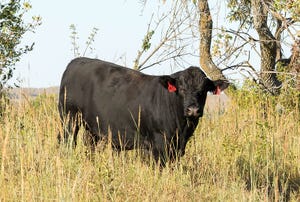Positive grazing conditions boost calf demand
Snug supplies and lush pasture prospects continue to underpin calf and yearling prices. Though fed cattle traded steady to lower in the spot market, Choice wholesale beef value reached a new high heading into Memorial Day.
May 23, 2015

Yearlings traded fully steady to $3 per cwt higher, according to the Agricultural Marketing Service (AMS) on Friday, with most of the advance on cattle heavier than 800 pounds.
Where tested, calves sold steady with instances of $5 higher.
“Demand for calves continues to improve with excellent grazing conditions around the country,” AMS analysts explain. “Range and pasture conditions are much improved over last year, especially in the Southern Plains where conditions in West Texas
and Oklahoma improved dramatically.”
Feeder Cattle futures could receive support from Friday’s Cattle on Feed report (see “Feedlot placements below expectations”). It was bullish with significantly lower April placements than expected. The report came out earlier than normal, during trade hours, but the response was relatively lukewarm (an average of $1.12 higher). Light trade on Friday suggests folks had already left for the holiday weekend, or there’s too much uncertainty about the impact of heavier placement weights as the market moves forward.
Cash fed cattle trade was sluggish again this week with prices generally steady to $1-$2 lower at $159-$161 per cwt on a live basis and steady to $4 lower in the beef at $250-$253. Week-to-week, Live Cattle futures were an average of $1.09 higher, except for 40¢ and 10¢ lower at the front of the Board.
“There is a huge price difference between where feeders and fat cattle are trading as cattle feeders are risking another dip in the red ink in their competition for yearling cattle,” AMS analysts say.
Wholesale beef values continued to move higher with this weekend’s unofficial opening to the summer grilling season. Choice boxed beef cutout value reached a new high this week at $266.77 per cwt. By the end of the week, Choice boxed beef cutout value was $1.68 per cwt lower week-to-week at $260.25. Select was $3.48 lower at $247.62.
“The next six weeks will be a good test to see if beef demand will hold up as we start the beginning of the grilling season,” AMS analysts say. “One of the key factors going forward is how overall cutout values hold up when retail promotions disappear. It will take strong buying clearance and the need to replenish and own inventory over the next six weeks to help hold values.”
According to Friday’s USDA Cold Storage report, there’s plenty of meat to go around.
Total frozen red meat supplies were 2% more than the previous month and 20% more than the previous year. Frozen beef supplies were 1% less than the previous month but 18% more year-over-year. Frozen pork supplies were 1% more than the previous month and 18% more than the previous year.
Total frozen poultry supplies were 6% more than the previous month and 21% more than a year earlier. Of that, total frozen chicken stocks were 2% more than the previous month and 31% more than the previous year.
On the other side of the equation, U.S. beef and pork exports regained momentum in March after starting the year slowly, according to the most recent data released by USDA and compiled by the U.S. Meat Export Federation (USMEF).
Though still below a year ago, March beef exports were 5% more month-to-month with beef export value 2% more year-over-year. The volume of U.S. pork exports was the most in 11 months.
“Port congestion remained an issue well into March – and even into April in the Southern California ports – but the announcement of the new labor contract certainly improved the business climate,” said USMEF President and CEO Philip Seng. “After months of frustration, the U.S. meat industry was finally able to reassure Asian buyers that the worst of the crisis was behind us and that they could once again count on the U.S. to fulfill its role as a reliable supplier. This was especially important for customers purchasing chilled pork and beef, which require very prompt delivery due to product shelf life.”
You might also like:
60+ stunning photos that showcase ranch work ethics
Don't bid away future profits by overpaying for cows
About the Author(s)
You May Also Like





